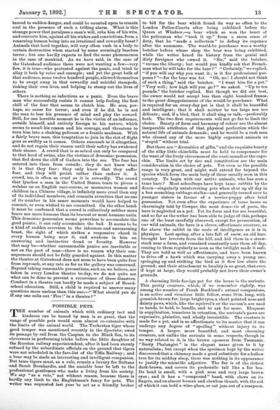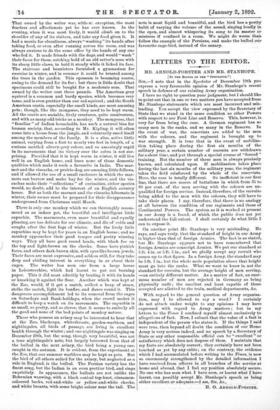POSSIBLE PETS.
THE number of animals which with ordinary tact and kindness can be tamed by man is so great, that the -range of possible pets would seem almost co-extensive with the limits of the animal world. The Turkestan tiger whose good temper was mentioned recently in the Spectator, owed its passage by rail from the Caspian to the Black Sea, to its • cleverness in performing tricks before the little daughter of the Russian railway superintendent, after it had been sternly refused by the subordinate officials on the ground that tigers -were not scheduled in the fare-list of the Tiflis Railway ; and -a bear may be Made an interesting and intelligent companion. But tame tigers must, as a rule, remain a luxury for Sultans -and Sarah Bernhardts, and the amiable bear be left to the -professional gentlemen who make a living from his society. We say "as a rule," not without reason, because there is hardly any limit to the Englishman's fancy for pets. The writer was requested last year 'to act as a friendly broker
to bid for the bear which found its way so often to the London Police-Courts after being exhibited before the Queen at Windsor,—a bear which so won the heart of the policeman who "took it up" from a stern sense of duty, that he "made a collection" to defray its expenses after the summons. The would-be purchaser was a worthy butcher before whose shop the bear was being exhibited, while the writer heard its history from the genial and dirty foreigner who owned it. "Sir," said the butcher, " excuse the liberty; but would you kindly ask that French- man what he will take for the bear ?" " Certainly," we replied, "if you will say why you want it ; is it for professional pur- poses P "—for the bear was fat. " Oh, no ! I should not think of such a thing," said the butcher. " I want him for a pet." " Very well ; how high will you go P " we asked. " Up to ten pounds," the butcher replied. But though we did our best, the owner would not accept less than eight hundred francs, to the great disappointment of the would-be purchaser. What is required for an every-day pet is that it shall be beautiful and intelligent; that it shall neither be too large nor too delicate; and, if a bird, that it shall sing or talk,—preferably both. The two first requirements will not go far to limit the choice. Beauty of form and harmony of colour are the almost inseparable attributes of that physical perfection which the natural life of animals demands ; and he would be a rash man who classed any of the more highly organised animals as " stupid " without trial.
But there are " diversities of gifts," and the exquisite beauty of the silky little chinchilla must be held to compensate for the want of the lively cleverness of the coati-mundi or the capu- chin. The limits set by size and constitution are the main consideration in the choice of pets. Yet even so the possible range is very great, and might well extend far beyond the species which form the main body of those usually seen in this country. To begin with our native animals, who has seen a tame hare ? Most schoolboys have kept tame rabbits by the dozen—singularly uninteresting pets when shut up all day in a box munching cabbage-stalks—and generally turned over to younger sisters in favour of a terrier-puppy after brief possession. Yet even after the experience of tame hares so charmingly told by Cowper, the most domestic of poets, the hare is neglected as a pet. Yet its form and fur are beautiful, and so far as the writer has been able to judge of this, perhaps one of the least carefully observed, except for persecution, of our wild animals, the hare is a clever, affectionate creature, as far above the rabbit in the scale of intelligence as it is in physique. Last spring, after a late fall of snow, an old hare brought her leverets from the hill, and hid them in a straw. stack near a farm, and remained constantly near them all day, coming to them regularly as soon as the twilight made it safe. They are bold as well as affectionate, and have been known to drive off a hawk which was carrying away a young one, springing up and striking the bird as it flew low above the ground; and their attachment to locality is so great, that even if kept at large, they would probably not leave their owner's grounds.
A charming little foreign pet for the house is the suricate. This pretty creature, which, if we remember rightly, was among the number of Frank Buckland's animal companions, is an active and vivacious little fellow, some 10 in. long, with greenish-brown fur, large bright eyes, a short pointed nose and dainty paws, which, like the squirrel's or the racoon's, are used as hands, to hold, to handle, and to ask for more. Eloquent in supplication, tenacious in retention, the suricate's paws are expressive, plaintive, and wholly irresistible. The creature is made for a pet, and is so affectionate to its master that it can undergo any degree of " spoiling" without injury to its temper. A larger, more beautiful, and most charming creature, not unlike the suricate in some respects, though in no way related to it, is the brown opossum from Tasmania " Sooty Phalangiet " is the elegant name given to it by naturalists ; but except when the specimen kept by the writer discovered that a chimney made a. good substitute for a hollow tree for its midday sleep, there was nothing in its appearance to justify the scientific adjective. The fur is of the richest dark-brown, and covers its prehensile tail like a far boa. Its head is small, with a pink nose and very large brown eyes ; and it has a "compound" hand, with claws on its fingers, and an almost human and clawless thumb, with the aid of which it can hold a wine-glass, or eat jam out of a teaspoon. That owned by the writer was, with( exception, the most fearless and affectionate pet be has ever known. In the evening, when it was most lively, it would climb on to the shoulder of any of its visitors, and take any food given it. It had a mania for cleanliness, always " washing" its hands after taking food, or even after running across the room, and was always anxious to do the same office by the hands of any one who fed it. It made friends with the dogs, and would " wash " their faces for them; catching hold of an old setter's nose with its sharp little claws, to hold it steady while it licked its face. The staircase and bannisters furnished a gymnasium for exercise in winter, and in summer it could be trusted among the trees in the garden. This opossum is becoming scarce, owing to the demand for its fur; but there is little doubt that specimens could still be bought for a moderate sum. That owned by the writer cost three pounds. The American grey squirrel is a common and hardy species, which becomes very tame, and is even prettier than our red squirrel; and the South American coatis, especially the small kinds, are most amusing pets; though, like the mongoose, they need to be kept warm. All the coatis are sociable, lively creatures, quite omnivorous, and with as many odd tricks as a monkey. The mongoose, that "familiar" of Indian households, has such a natural bias for human society, that, according to Mr. Kipling. it will often come into a house from the jungle, and voluntarily enrol itself among the members of the family. It is a slim, active little animal, varying from a foot to nearly two feet in length, of a curious mottled silvery-grey colour, and so amazingly rapid in its movements that its victory over the cobra is not sur- prising. Provided that it is kept warm in winter, it will live well in an English home, and loses none of those domestic qualities which make it such a favourite in India. The mar- mot and the viscacha, or prairie-dog, are amusing little fellows, and if allowed the use of a small enclosure in which the mar- mots can burrow and make bay for the winter, and the vis- cachas make their " collections " of curiosities, either species would, no doubt, add to the interest of an English country house. But as both the marmot and the viscacha hibernate in winter, their owner must be prepared for their disappearance underground from Christmas until March.
There is only one monkey which we can thoroughly recom- mend as an indoor pet, the beautiful and intelligent little capuchin. The marmozets, even more beautiful and equally pleasing, are too delicate for our climate, and die of colds and coughs after the first fogs of winter. But the lively little capuchins may be kept for years in an English house; and no monkey approaches their good temper and pretty winning ways. They all have good round heads, with black fur on the top and light-brown on the cheeks. Some have pinkish faces, and others dark-brown skin, with eyes like brown jewels. Their faces are most expressive, and seldom still, for they take deep and abiding interest in everything in .or about their cages. The writer has seen one from a large house in Leicestershire, which had learnt to put out burning paper. This it did most adroitly by beating it with its hands or knocking it against the floor. Another which was kept at the Zoo, would, if it got a match, collect a heap of straw, strike the match, light its bonfire, and dance round it. This dangerous accomplishment led to its removal from the cages on Saturdays and Bank-holidays, when the crowd makes it difficult to keep a watch on its movements. The capuchin is so small, so pretty, and so clever, that it seems to embody all the good and none of the bad points of monkey nature.
Those who possess an aviary may be interested to hear that at the Zoo, blackcaps, whitethroats, garden-warblers, and nightingales, all birds of passage, are living in excellent health through the winter; and one nightingale was singing on December 29th, but the• song, though very beautiful, was not a tree nightingale's note, but largely borrowed from that of the bulbul in the next aviary, the bird being a young one, caught in the autumn. It is evident, from the experiment at the Zoo, that our summer warblers may be kept as pets. But the bird of all others suited for the aviary, but neglected as a rale in England, is the bulbul. The Persian variety has the finest song, but the Indian is an even prettier bird, and sings exquisitely. In appearance, the bulbuls are not unlike the Bohemian waxwing, with a black conical top-knot, cinnamon- coloured backs, red•and-white or yellow-and-white cheeks, and white breasts, with some bright colour near the tail. The
note is most liquid and beautiful, and the bird has a pretty habit of varying the volume of the sound, singing loudly in the open, and almost whispering its song to its master or mistress if confined in a room. We might do worse than follow the example of the Persians, and make the bulbul mit- favourite cage-bird, instead of the canary.















































 Previous page
Previous page